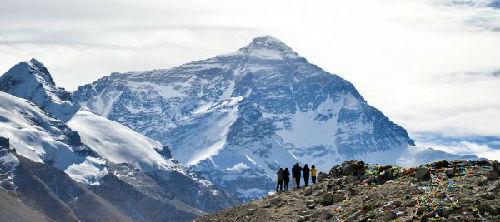Glaciers of the Tibetan plateau "burning cow dung" face melting air pollution threats | | | melting glaciers on the Tibetan plateau _ news
 This was taken November 23, 2015 at Everest base camp of Mount Everest. Mount Qomolangma is 8844.43 meters above sea level the peaks of the Himalayas, located in China and Nepal on the border, is the highest peak in the world, its northern slope in the Chinese territory of Tibet.
This was taken November 23, 2015 at Everest base camp of Mount Everest. Mount Qomolangma is 8844.43 meters above sea level the peaks of the Himalayas, located in China and Nepal on the border, is the highest peak in the world, its northern slope in the Chinese territory of Tibet. Reference news, August 26 US media said, when discussing the glaciers melted, and most people will immediately think of the huge ice sheets of Greenland and Antarctica. But there are people on the planet to talk about not so much glaciated regions have largely melted, survival and water supply to millions of people at risk.
According to the United States, the Washington Post, August 24, the Himalaya-Hindu Kush mountains and the Tibetan plateau was covered by ice and snow, in Central Asia and East Asia the area occupied, the ice in the polar regions of the Earth's largest region. In fact, it won the "third pole" nickname. But as with Greenland and Antarctica, it also faces a problem: the "third pole" of the glaciers are shrinking.
Reported, according to the Institute of remote sensing data collection and analysis, over the past 50 years, China has only about 18% of the glaciers disappear. This is a huge problem, because these glacier meltwater to flow to large number of rivers, these rivers provide water to the 1 billion people downstream, directly or indirectly.
Chinese Academy of Sciences, said Kang shichang, a Professor of the Institute of Tibetan plateau and global warming-induced temperature rise is a threat to glaciers. But the region's air pollution accelerates melting. Now Kang shichang and his colleagues on the pollution comes from, how to prevent pollution with new discoveries.
New research published in the August 23 issue of nature newsletter, researchers have collected a third sample of carbon black, carbon black is particulate matter produced by combustion of fossil fuels and biofuels, they use special chemical "fingerprint" methods to study, to determine what they are burning, where they came from.
Reported that the carbon black is best known for is that it can cause a range of adverse effects on health, including diseases of the respiratory and cardiovascular system, and even premature death. As for its effect on glaciers, it is known to cause snow and ice to melt in many ways. Kang shichang pointed out, first of all, floating in the air of carbon black to absorb sunlight, at least in a short time caused regional warming. In addition, if black carbon falls on the ice, snow and ice surfaces become darker in color, so that it absorbs more sunlight, melting more quickly.
So far, scientists have failed to make it clear that where the pollution to Himalayan and Tibetan plateau region had an impact, also failed to determine which sources of harmful. These are very important not only to establish precise glacier model, forecasting the future glacier change, also contribute to the development of the new policy, targeted at areas of greatest need to cut pollution.
In the new study, the researchers found evidence that fossil fuels and biofuels-such as plant and animal dung-burning is "third pole" sources of black carbon. In the Himalayas, both sources essentially flat, most of the carbon black from India North India-Gangetic plain, in the North of Qinghai-Tibet plateau, most of the black carbon from China's burning of fossil fuels.
But in the inland area of Central Qinghai-Tibet plateau, two-thirds samples of carbon black from bio-fuels instead of fossil fuels, said Kang shichang, the finding was "very surprising". This means that the combustion behavior of fuel in central Tibet, such as cooking heat burning yak dung every day to the "third pole" some pollution more than experts previously thought.
Reportedly, this is a very valuable data, able to simulate the "third pole" melting glaciers, forecast models provide better data for the region's future. But Kang shichang says: "most important is our ability to provide decision makers with mitigation recommendations of the melting glaciers. ”
Responsible editor: Chen yan SN225
Article keywords:Air pollution in melting glaciers on the Tibetan plateau
I want feedback
Save a Web page
Oriental NET
青藏高原冰川因“烧牛粪”面临融化威胁|空气污染|青藏高原|冰川融化_新闻资讯
 这是2015年11月23日在珠峰大本营拍摄的珠穆朗玛峰。海拔8844.43米的珠穆朗玛峰是喜马拉雅山脉的主峰,位于中国和尼泊尔两国边界上,是世界第一高峰,其北坡在中国西藏境内。
这是2015年11月23日在珠峰大本营拍摄的珠穆朗玛峰。海拔8844.43米的珠穆朗玛峰是喜马拉雅山脉的主峰,位于中国和尼泊尔两国边界上,是世界第一高峰,其北坡在中国西藏境内。 参考消息网8月26日报道美媒称,当讨论冰川融化时,大部分人会立刻想到格陵兰岛和南极洲的巨大冰原。但是地球上还有一个人们谈论没那么多的冰川覆盖地区面临大规模融化,数百万人的生存和水供应因而存在风险。
据美国《华盛顿邮报》网站8月24日报道,喜马拉雅-兴都库什山脉以及青藏高原被冰雪覆盖,占据了中亚和东亚广大区域,成为极地地区之外地球上最大的冰雪地区。实际上,它为自己赢得了“第三极”的昵称。但是与格陵兰岛和南极洲一样,它也面临着问题:“第三极”的冰川也在缩减。
报道称,根据中科院搜集和分析的遥感数据,在过去50年,仅中国就有约18%的冰川消失。这是一个巨大的问题,因为这些冰川的融水流向一大批河流,这些河水向下游10亿人口直接或间接提供水源。
中科院青藏高原研究所教授康世昌说,全球变暖引发的温度上升的确是冰川面临的一个威胁。但是该地区空气污染也加速了融化。现在康世昌及他的一批同事就污染来自何处、如何制止污染有了新的发现。
新研究发表在8月23日的《自然·通讯》上,研究人员搜集了第三极炭黑样本,炭黑是化石燃料和生物燃料燃烧产生的特殊物质,他们用特殊的化学“指纹”处理方法对其进行了研究,以判定它们是何种燃烧产生的,来自何处。
报道称,炭黑最著名的是它可能对健康造成一系列不利影响,包括呼吸系统和心血管系统疾病,甚至过早死亡。至于它对冰川的影响,已知它会以多种方式引起冰雪融化。康世昌指出,首先,漂浮在空气中的炭黑能吸收太阳光,至少会在短时间内引起区域性变暖。另外,如果炭黑落在冰雪上,会让冰雪表面颜色变深,使其吸收更多太阳光,融化得更快。
迄今为止,科学家们未能明确指出何处的污染给喜马拉雅和青藏高原哪个地区带来了影响,也未能确定哪种污染源带来的危害最大。这些情况是非常重要的,不仅有助于建立精确的冰川模型,预测冰川未来变化,也有助于制定新的政策,有针对性地在最有需要的地方削减污染。
在新研究中,研究人员发现证据证明,化石燃料和生物燃料——例如植物和动物粪便——燃烧是“第三极”炭黑的来源。在喜马拉雅地区,这两种来源基本持平,大部分炭黑来自于印度北部印度河—恒河平原,而在青藏高原北部,大部分炭黑来自于中国燃烧的化石燃料。
但是在青藏高原中部内陆地区,三分之二的炭黑样本来自于生物燃料而不是化石燃料,康世昌说,这一发现“非常令人惊讶”。这意味着西藏中部的燃料燃烧行为,例如每天做饭取暖燃烧的牦牛粪便,给“第三极”某些部分带来的污染比专家之前想象得更多。
报道称,这是非常有价值的数据,能为模拟“第三极”冰川融化、预测该地区未来的模型提供更好的数据。不过康世昌认为:“最重要的是我们能向决策者提供缓解冰川融化的建议了。”
责任编辑:陈琰 SN225
文章关键词: 空气污染 青藏高原 冰川融化
我要反馈
保存网页
东方网